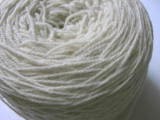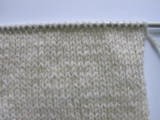

Yarn Profile: Maine Merino First Impressions
The yarn -- Maine Merino -- is produced by the Ahern family in coastal Maine. They share their 20-acre farm with a milking cow, pigs, chickens, and 25 merino sheep. Each year, the Aherns send 100 pounds of fiber to the Blackberry Woolen Mill for processing. It returns in jumbo-sized skeins of delicious yarn, which they sell on their Maine Merino Web site. The Aherns alternate years, offering pure merino one year and a merino blend (with small amounts of alpaca, angora, silk, etc.) in other years. Word about Maine Merino is spreading. Last year alone, it was used for several prize-winning garments at major East Coast fiber festivals. For this review, I focus on the pure two-ply merino yarn, which is available in lace and sport weights. Knitting Up
Maine Merino knit up like a dream. Its soft, fuzzy, relatively elastic form slid through my fingers effortlessly. It has a subtle variation in thickness that reminded me of its all-natural cousin, Granite State Green. Stitches appeared fairly smooth, with just a slight unevenness that I happen to find appealing. Blocking / Washing
My rather nondescript swatches dried into perfect flat squares of soft, cohesive knit fabric. Even my non-knitting friends, when enlisted to admire yet "another" swatch of yarn, could immediately feel the difference. The swatches required only a small amount of blocking after I squeezed them dry in a towel. Once dry, they resisted my crooked, tugging temptations and retained their shape perfectly. Wearing
After a decent amount of friction, a discreet extra layer of fuzz began to emerge on the already fuzzy surface of the swatches. Gradually this fuzz became a sea of barely discernible pills. Trying to pull them all would drive even the most patient knitter crazy. A battery-powered sweater shaver quickly did the trick. Conclusion
For handwash-friendly parents, I'd also recommend Maine Merino for any children's garments. If you like sleek, consistent designer yarns in multitudes of colors, Maine Merino probably won't appeal. Its beauty lies in its pure, direct-from-the-farm simplicity, rather like a perfect ear of corn from a roadside farm stand. |
Yarn name
Maine Merino
Manufacturer
Maine Merino
Fiber content
100% merino wool
Gauge
Sport weight (6 to 6.5 stitches per inch on US 4 to 6); lace weight (7-8 stitches per inch on US 1 to 2)
Average retail
price
$25/skein for sport weight $12.50/skein for lace weight
Where to Buy Online
Maine Merino<
Weight/Yardage per Skein
8oz./350 yards in sport weight 4oz./350 yards in lace weight
Country of Origin
U.S.A.
Manufacturer's
suggested wash method
None given. Our advice: Hand wash in lukewarm water with mild soap. Avoid excess agitation. Roll in towel to remove moisture and lay flat to dry.
Review date
2/28/2002 |
Copyright © 2000-2016 Clara H. Parkes
All rights reserved. Permission to reproduce is required.
All rights reserved. Permission to reproduce is required.
